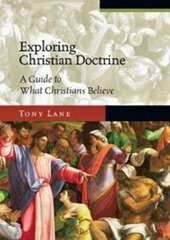 Tony Lane, Exploring Christian Doctrine: A Guide to What Christians Believe
Tony Lane, Exploring Christian Doctrine: A Guide to What Christians Believe
InterVarsity Press, 2014, $30. 308 pages. Review by Chris Castaldo
Family is important. It is a weight-bearing beam that orients and stabilizes our identity. It gives rise to an array of values and priorities, including one’s basic instincts. Indeed, our family heritage is responsible for giving shape to much of life as we know it.
We sometimes fail to recognize that entrance into God’s family, as in our biological clan, also involves a history. The faith that was first delivered to the saints has been passed down to us, generation to generation. Unfortunately, however, for many of us in the evangelical world, historical awareness of the Christian faith fails to rise above the so called “Ditch Theory.” According to this perspective, Jesus and the Apostles understood and practiced devotion to Christ in all of its purity and depth. Such fidelity to the apostolic tradition continued until Emperor Constantine elevated Christianity as the official religion of the empire, at which point the Church promptly fell into the ditch of compromise and heresy. From the period of Constantine through the Medieval Age, the gospel was thus immersed in unbiblical tradition and therefore largely misunderstood, apart from a small remnant of believers who somehow managed to get it right. Eventually, God empowered Martin Luther to confront these errors, which he initiated in 1517 when he nailed his 95 Theses to the castle church door at Wittenberg. With Luther and the reform movements that followed, Christianity was elevated three quarters of the way out of the ditch. In this nearly-restored condition, biblical Christianity remained until the founding of one’s particular denomination or church, at which point pure, biblical faith was finally returned to its original condition. Hopefully, the reductionist nature of this view is apparent.
Enter Professor Tony Lane and his new book titled Exploring Christian Doctrine: A Guide to What Christians Believe. As an undergrad at Oxford University, Tony acquired an interest in historical theology during two terms of concentrated patristic study. Along the way, Tony read John Henry Newman’s famous assertion, “To be deep in history is to cease to be Protestant.” For Tony, Newman’s statement brought into sharper focus the need for evangelical Protestants to carefully and convincingly articulate our historical/theological continuity. On some level, Exploring Christian Doctrine may be regarded as an answer to Newman’s claim.
Tony Lane (DD, University of Oxford) is professor of historical theology and director of research at the London School of Theology. He is the author of numerous books, including Concise History of Christian Thought, John Calvin: Student of the Church Fathers, and Justification by Faith in Catholic-Protestant Dialogue. Full disclosure, Tony is my doctoral supervisor. However, to be honest, beyond our friendship, my bias is mostly based on my appreciation for his punctilious approach to research and delightfully clear and readable prose. The book under review displays both of these virtues.
This book originated as a series of lectures for undergraduate theology students. But, as explained in the introduction, it is written to be accessible to the educated layperson so that it may also be used in churches and discipleship gatherings. With this audience in mind, the book pursues several objectives. First and foremost, it seeks to provide a basic account of Christian beliefs. These accounts show how theological ideas have developed historically and should therefore be understood contextually. Key historical texts, especially creedal statements, punctuate each section indicating where lines of commonality and difference fall between various Christian traditions. There is also a commitment to pointing out the interconnectedness between doctrines, highlighting common threads such as the person and work of Christ. Finally, attention is given to the way doctrines relate to the contemporary world, that is, to the life of the Church and to wider culture.
The book’s overall scope and sequence reflects a redemptive historical approach to doctrine. After some introductory chapters, it examines “Creation,” “Sin and Evil,” “Redemption,” and “Future Glory.” Tony treats these subjects as an Evangelical Christian who consciously draws upon a wide range of Christian traditions. This “eclectic” approach seeks to capture the breadth of Christian thought, without limiting itself to a particular confession. And it seeks to be explicitly biblical, which is why the book contains so many scriptural quotations.
There are numerous portions of this volume that we could excerpt as an illustration of how Tony manages to strikes the delicate balance of substantive instruction with readability and applicability. Here is one arbitrarily chosen example:
Bernard of Clairvaux described five different reasons for the pursuit of knowledge. To seek it for its own sake is curiosity; to seek it for fame is vanity; to seek it to gain money or honours is profiteering; to seek it to be of benefit to oneself is prudence; to seek it to be of service to others is love (Sermons on Song of Songs, 36:3). There is a legitimate role for all five motives –students can rightly be concerned about obtaining good grades and finding a good job after their studies. But to study theology without the desire to benefit oneself and others it to miss the point of it (2).
Each chapter of Exploring Christian Doctrine also contains special features. Among them are the “Skeptics Corner” (a common objection with Tony’s answer), Credal Statements, Error(s) to Avoid, Tension to Hold, Worship (an extract from a hymn or worship song), and Prayer (usually from a historical source), Resources (suggested reading), and Technical Terms, where clear definitions are provided. There are cross references in the text to figures and important doctrinal statements from the past, including the Catechism of the Catholic Church to get a succinct and authoritative summary of contemporary Catholic teaching. Finally, full biblical passages are typically quoted (from the ESV translation) instead of simply including a reference.
If I have one disappointment with the book, it is the lack of attention given to the ecumenical task of the church. In this post secular moment, when evangelical Protestants find themselves standing beside Catholics on a host of cultural issues—everything from serving the poor, advocating on behalf of the unborn, upholding a biblical definition of marriage, defending religious freedom, and encouraging public policy that promotes human flourishing—it would be valuable to get historical perspective on some of the objectives and etiquette of ecumenism. I make this point partly because Tony has demonstrated an ability to engage this subject with an admirable quality of insight and grace, such as in his book Justification by Faith in Catholic-Protestant Dialogue (T&T Clark, 2002, 2006). One certainly understands, though, that there are limits to what a single volume can realistically address.
As I consider the various classes and programs of my local church, we appear to excel in the exposition of Scripture (thankfully), but unfortunately there is a sizable omission in the realm of Christian doctrine, particularly from a historical point of view. Perhaps your church is similar. If so, you might consider Exploring Christian Doctrine as a text to help your congregation give an answer for its theological hope.




